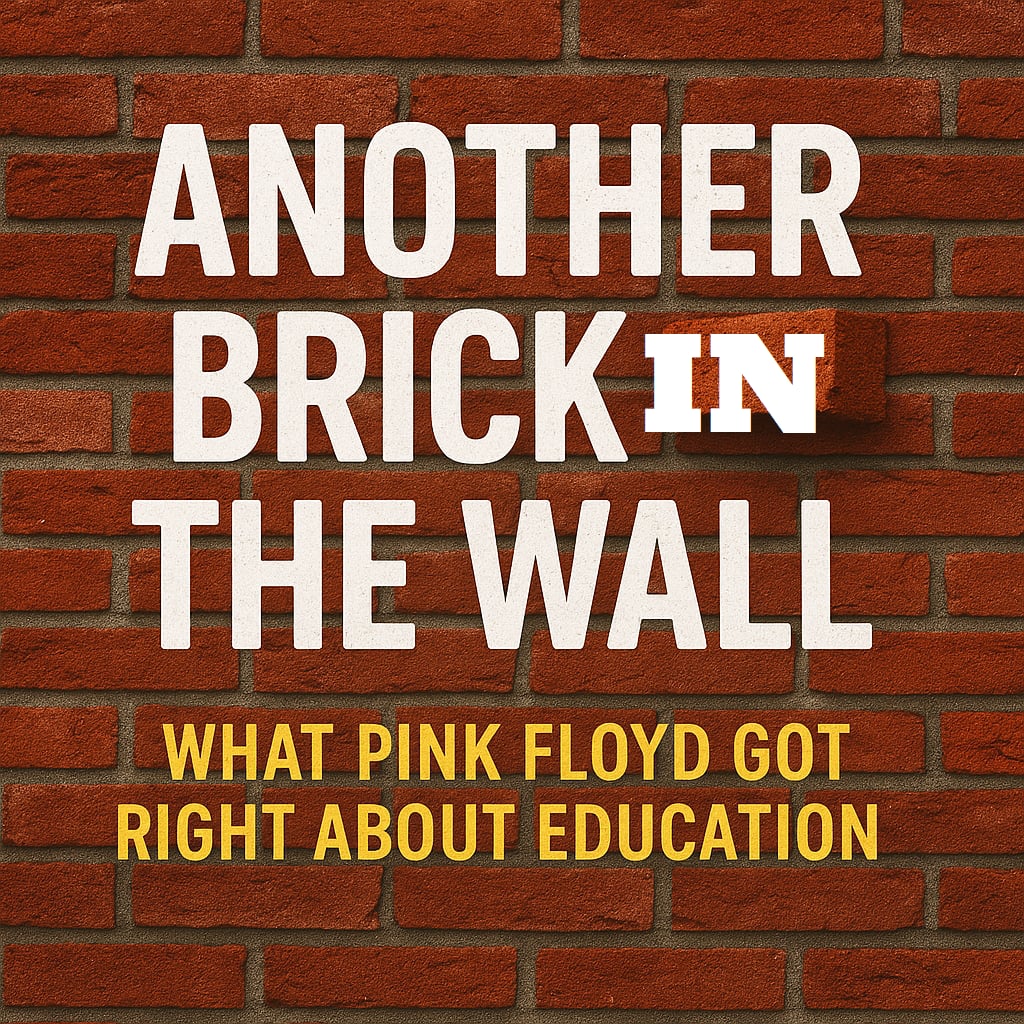
As I squeezed in one last workout before heading to Dubai to speak on a topic close to my heart—helping all students find their brilliance—a familiar beat started playing in the gym: Pink Floyd’s Another Brick in the Wall. I’ve heard it countless times before, but today, the lyrics hit differently. The song’s message about the failure of rigid education systems to honor the individual feels more relevant than ever.
Pink Floyd’s The Wall isn’t just a rock song—it’s a powerful narrative about trauma, isolation, and the institutional systems that can strip individuals of their humanity. “Another Brick in the Wall, Part 2” criticizes a cold, authoritarian school system. And even though it was written over 40 years ago, its warning still echoes in classrooms today.
The album follows the character “Pink,” who, over time, builds a metaphorical wall between himself and the world. Each painful event in his life—loss, abandonment, war, and especially school—is “another brick in the wall.” In this context, school becomes not a sanctuary for growth, but a factory of compliance and control.
“We don’t need no education. We don’t need no thought control.”
This isn’t a cry for ignorance. It’s a plea to stop dehumanizing students in the name of structure, to stop turning learning into a lifeless, standardized process.
Many of the world’s most creative minds—actors, artists, musicians, inventors—have shared how school felt suffocating, uninspiring, or even painful. Why? Because traditional schooling often champions convergent thinking—getting the one “right” answer—while suppressing divergent thinking, the source of creativity, curiosity, and problem-solving.
Robin Williams once said:
“I was getting in trouble a lot in school. I was the class clown. But nobody saw it as talent—just disruption.”
Jim Carrey reflected:
“I spent most of my school years trying to make people laugh and avoid the fact that I wasn’t connecting with the material at all.”
Albert Einstein, often misunderstood in school, famously remarked:
“It is a miracle that curiosity survives formal education.”
Thomas Edison was told he was “too stupid to learn anything.” His mother pulled him from school and nurtured his curiosity—thankfully. The result? Over a thousand patents that shaped modern life.
These stories reveal a deep contradiction: we say we value creativity in education, yet the system often rewards conformity and punishes those who don’t fit the mold.
Today, many students still feel unseen—reduced to data points or behavior reports. When we put policies before people, and standardization above relationships, we risk doing exactly what Pink Floyd warned us about: turning schools into factories and children into faceless bricks in a wall.
Education should be about:
- Connection over compliance
- Empowerment over obedience
- Creativity over conformity
- Hope over hopelessness
We must build classrooms where curiosity is currency. Where creativity is celebrated. Where every child’s uniqueness is an asset—not a problem.
As someone who has spent decades working with educators and leaders across the globe, I’ve seen firsthand that creativity in children is not rare—it’s the norm. Nearly all young children demonstrate high levels of creativity, but that creativity often diminishes as they progress through school. And it’s not because they grow out of it—it’s because we teach it out of them.
The very traits we celebrate in artists and entrepreneurs—imagination, risk-taking, unconventional thinking—are too often labeled as distractions in traditional classrooms. We say we want students to be problem-solvers, but we give them fill-in-the-blank worksheets. We say we value innovation, yet we reward repetition.
In my keynote in Dubai, I’m focusing on exactly this: helping every child find their brilliance. That means moving beyond weaknesses and remediating gaps. It means recognizing and developing students’ strengths, igniting their passions, and creating environments where their brilliance can shine.
When we make space for creativity, voice, and agency, something powerful happens—students don’t just learn, they come alive. The goal isn’t to prepare them for the test; it’s to prepare them for life—with confidence, purpose, and belief in themselves.
If we’re serious about unlocking student potential, we must shift our focus from control to connection. From conformity to creativity. It’s not enough to say we value these things—we must build schools and classrooms that reflect them in practice. The wall is built one brick at a time. So is the bridge. We get to choose what we build.
Every decision we make as educators is either building a child up—or stacking another brick in their emotional wall. Ask yourself:
- Am I teaching to inspire—or to control?
- Do my students feel seen—or sorted?
- Am I nurturing thinkers—or manufacturing test-takers?
The next Einstein, Edison, or Robin Williams could already be sitting in your classroom—bored, misunderstood, and waiting for someone to see them.
Instead of fitting students into a rigid system, let’s focus on creating an environment that celebrates their unique strengths and talents. We can build bridges to their brilliance by:
- Encouraging curiosity over compliance.
- Fostering individuality and creative expression.
- Supporting emotional intelligence and resilience alongside academics.
- Recognizing potential beyond test scores.
Let’s build bridges to their brilliance, not walls with their weaknesses.